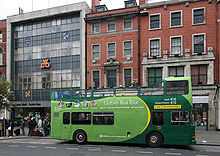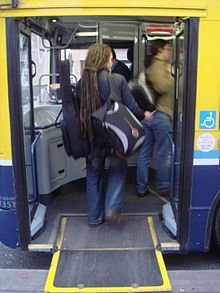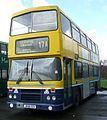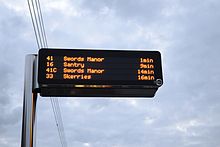- Dublin Bus
-

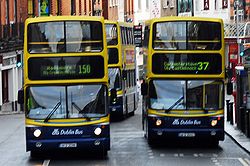
Various Dublin Bus Alexander ALX400sParent Coras Iompair Éireann Founded 1987 Headquarters Dublin Locale Ireland Service area Dublin Service type Urban Fleet 1,031 Daily ridership 500,000 (weekdays) Fuel type Diesel Operator Private limited company by shares Web site www.dublinbus.ie Dublin Bus (Irish: Bus Átha Cliath) is a public transport operator in Ireland. It operates an extensive bus network of 172 radial, cross-city and peripheral routes and 18 night routes in the city of Dublin and the Greater Dublin Area. The company, established in 1987, is a subsidiary of Córas Iompair Éireann which is owned by the Government of Ireland. Dublin Bus operates the vast majority of bus services in Dublin but in recent years an increasing number of other bus companies have received licences to operate in Dublin from the Department of Transport.
Contents
Background
Dublin Bus is the main transport provider in the Greater Dublin Area and carries 70% of all peak time public transport users into Dublin.[1] The network carries on average 500,000 customers a day and 150 million a year.[1] The company currently employs around 3,729 full-time staff members and utilises a fleet of 1,031 buses.[1]
Fares
Dublin Bus fares are generally calculated on a stage system based on distance travelled. There are several different levels of fares, which apply on most services. Certain routes (particularly Xpresso, see below) use a different fare system.
Dublin Bus follows an "exact fare - no change" policy on almost all buses for passengers who pay cash fares - to minimise the risk of staff being robbed, passengers must place the exact fare in coins (notes are not accepted as the counting machines in the garages cannot process them) in the fare box before the ticket is issued; in the case of overpayment a "change ticket" is issued which can only be exchanged for cash at the company's head office on O'Connell Street. The only exception are routes 747 and 748, the express routes to and from Dublin Airport, where with a minimum fare of €6, banknotes are accepted and change is given in cash.
There are several types of pre-paid tickets available, including:
- single day and multi-day tickets ("Rambler" and "Travelwide")
- tickets corresponding to cash fares (on airport or Nitelink services)
- 90 minute tickets which allow unlimited travel (or more precisely the right to board as many buses as required) for 90 minutes (only available as a ten use smartcard)
- tickets valid on Dublin Bus and Iarnród Éireann or Luas or all three, although tickets valid for all three systems are only issued by Iarnród Éireann
All prepaid tickets must be validated in a machine by the door of the bus at the start of each journey.
Old age pensioners and certain other people are allow to travel free of charge; this is part of the national "Free Travel Pass"[2] system operated by the Department of Social Protection.
Minimum fares are payable on some services in order to discourage passengers wishing to travel short distances from using seats which could be used by those who wish to travel longer distances. A standard fare (currently €50) is theoretically payable by those who evade payment of the full fare for the journey, but is rarely collected.
The main radial routes are focused upon Dublin's sixteen Quality Bus Corridors which provide buses with daytime access to the city centre.
Express buses (branded "Xpresso") operate on similar routes, but have a limited number of stops and a higher minimum fare.
Dublin Bus operates a "Nitelink" service of approximately 24 routes overnight which up until January 2009 ran between Monday and Saturday, with the greatest service frequency being on Friday and Saturday nights, however the midweek schedule was scrapped causing consternation with commuters. Special (higher) fares apply on Nitelink buses.
No "Park and Ride" services are available.
There is also a unique Ghost Bus Tour through some of the supposedly haunted places in the city.
In April 2010, Dublin Bus announced it would be simplifying many of its routes around the city in order to create better efficiency. However, as part of these measures, the company also announced that 150 jobs would be lost. [3][4]
Route network
Route Map
Uniquely for a capital city's primary transit network, no full systemwide street map is available online. Dublin Bus cites high licensing fees from its fellow state owned sister company, Ordnance Survey Ireland. A print map is published erratically every few years.
Fleet
Dublin Bus Fleet @13/10/2011: [7] Class Size Body Chassis Introduced Number AV Double Deck Alexander ALX400 Volvo B7TL 2000–2005 434 AX Double Deck Alexander ALX400 Volvo B7TL 2006 200 DT Double Deck Alexander ALX400 Dennis Trident 2 2003 10 EV Double Deck Alexander Dennis Enviro400 Volvo B9TL 2007–2008 100 RV Double Deck Alexander R-type Volvo Olympian 1997–1999 81 VG Double Deck Wright Eclipse Gemini Volvo B9TL 2008–2009 50 VT Double Deck Alexander Dennis Enviro500 Volvo B9TL 2005, 2007 70 WH Double Deck Wright Pulsar Gemini HEV Based on VDL DB250LF 2008 1 WV Midibus Wright Crusader 2 Volvo B6BLE 1999–2000 12 Gallery
Notes
Notes: 1. The RV Class are currently in the process of being withdrawn. This process is to be completed by 2012. 2. There are still many RA and RH class Olympians, in service on the Tours and Training fleets. History and Preservation
 Original logo from 1987 to 2000
Original logo from 1987 to 2000
 Dublin Bus logo 2000-2007. Both this and the current logo are based on the logo used 1987-2000.
Dublin Bus logo 2000-2007. Both this and the current logo are based on the logo used 1987-2000.
As the vehicles become of age they have been withdrawn to make way for newer technology. Types of significance such as the Bombardier/GAC (Irish built) have been preserved by the National Transport Museum of Howth who house R1 (the first double decker service bus in Ireland).
Many ex-CIE types have been acquired for preservation by private preservationists, some of whom associated with the Transport Enthusiasts Club (TEC). The vehicles are garaged, restored and run by the owners without state funds and take part in films, television programs and in vintage rallys. One event was CIE60th. The 30 October 2005 saw Dublin Bus host CIE60th in the new Harristown depot. This event was done in co-ordination with the Transport Enthusiasts Club. Buses new and old were on display showing the contrast and how far the company had come.
Dublin's main bus operator was formerly the Dublin United Transport Company. This company was incorporated into CIÉ in 1945, but regained partial autonomy in 1987 when Dublin Bus was created as a wholly owned subsidiary company of CIÉ.
Accidents
Accidents which made headline news;
Wellington Quay
On 21 February 2004 at Wellington Quay, Dublin, a bus mounted on a pavement and ploughed into a queue of 30 people, killing five and injuring 14. The driver was charged with dangerous driving, his trial began in February 2007 at Dublin Circuit Criminal Court. He has since been found not guilty of any misdoings.[8]
Bus Roof Damage
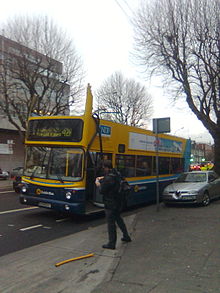 Bus accident on 5 February 2009 at North Strand Road.
Bus accident on 5 February 2009 at North Strand Road.
On 5 February 2009 a bus travelling from Abbey Street to Artane collided with a tree on North Strand Road and the entire roof section was torn off. The driver was treated in hospital with shock but apart from that there was no injuries as no passengers were seated in the upper saloon. The bus was an Alexander ALX400.[9]
Luas and Dublin Bus crash
On 16 September 2009 at 3pm, a collision between the Red Line Luas and a number 16 Dublin Bus from Ballinteer to Santry in Dublin City Centre at the intersection of Abbey Street and O'Connell Street injured 21 people. Three people, including the Luas driver, were cut out of the wreckage. The Luas was derailed in the accident. Two female passengers remained trapped on the bus for up to 45 minutes after the crash.[10][11][12][13][14][15][16][17]
Bus Arrival Information Service
The Bus Arrival Information Service is being rolled out across Dublin, and provides real time estimates of bus arrivals at certain bus stops, based on current GPS locations of buses. It is being run by the National Transport Authority under the brand Transport for Ireland, a single portal providing information on public transport in Ireland.
See also
- List of Irish companies
References
- ^ a b c Dublin Bus corporate information
- ^ Department of Social and Family Affairs
- ^ http://www.insideireland.ie/index.cfm/section/news/ext/dublinbus001/category/1084
- ^ "http://www.dublinbus.ie/en/Your-Journey1/Timetables/All-Timetables/9/". http://www.dublinbus.ie/en/Your-Journey1/Timetables/All-Timetables/9/. Retrieved October 21, 2011.
- ^ dublinbus.ie (13th of October 2011)
- ^ dublinbus.ie (13th of October 2011)
- ^ Dublin Bus Fleet (13th of October 2011)
- ^ Irish Independent National News
- ^ "Bus passengers escape injury as roof ripped off in Dublin crash – The Irish Times – Thu, Feb 05, 2009". The Irish Times. 2009-02-05. http://www.irishtimes.com/newspaper/breaking/2009/0205/breaking31.htm. Retrieved 2009-06-23.
- ^ 21 hurt as Luas collides with bus in Dublin – RTÉ News
- ^ The Irish Times – Wed, Sep 16, 2009 – Luas collides with bus in Dublin
- ^ 26 injured as Luas and bus collide | Irish Examiner
- ^ Luas tram and Dublin Bus collide in serious crash – national News, Breaking News – Independent.ie
- ^ Several injured as Luas tram and bus collide in Dublin | Irish News | Irish Central
- ^ http://www.google.com/hostednews/canadianpress/article/ALeqM5hFu6mhrpWVkj9fuHtzD4YqpHUDGw
- ^ Most Popular | Global Post
- ^ http://www.google.com/hostednews/ukpress/article/ALeqM5g5pfKW93xaOFo9sbhxsNhTrdCyIA
External links
Córas Iompair Éireann (CIE) Transport in Dublin Air Rail Tram*Road Bus corridorsR101 · R102 · R103 · R104 · R105 · R106 · R107 · R108 · R109 · R110 · R111 · R112 · R113 · R114 · R115 · R116 · R117 · R118 · R119 · R120 · R121 · R122 · R123 · R124 · R125 · R126 · R127 · R128 · R129 · R130 · R131 · R132 · R133 · R134 · R135 · R136 · R148 · R156 · R403 · R445 · R761 · R810 · R817 · R821 · R822 · R824 · R825 · R826OtherWater CanalsPortsAgencies *=Tram systems no longer run. Information in parentheses shows the operator(s)Categories:- Córas Iompair Éireann
- Bus transport in the Republic of Ireland
- Bus companies of the Republic of Ireland
- Transport companies of the Republic of Ireland
- Transport in County Dublin
Wikimedia Foundation. 2010.

